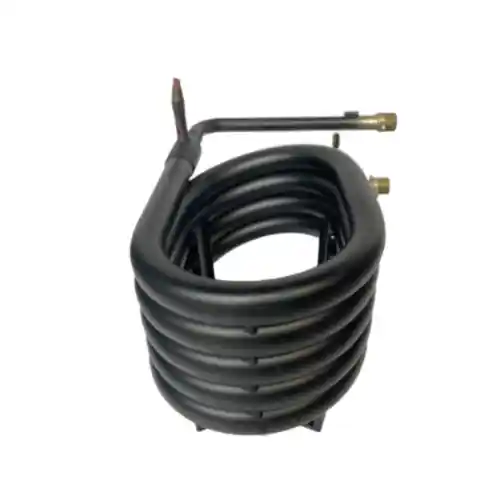1. Introduction
Titanium-aluminum composite tubes have emerged as a groundbreaking solution for advancing the performance and efficiency of coaxial heat exchangers. This article explores the characteristics of titanium-aluminum composite tubes, their advantages, and their impact on the effectiveness of coaxial heat exchangers. We will delve into the composition of composite tubes, their thermal properties, corrosion resistance, and compare them with other tube materials commonly used in heat exchangers.
2. Composition and Structure of Titanium-Aluminum Composite Tubes
Titanium-aluminum composite tubes consist of an inner titanium tube and an outer aluminum tube. These tubes are bonded together to create a composite structure that combines the unique properties of both materials. The following table provides an overview of the composition and structure of titanium-aluminum composite tubes:
| Composite Tube Structure | Composition |
|---|---|
| Inner Tube | Titanium (Ti) |
| Outer Tube | Aluminum (Al) |
| Bonding Layer | Titanium/Aluminum interface or layer |
3. Advantages of Titanium-Aluminum Composite Tubes in Coaxial Heat Exchangers
3.1 Superior Thermal Conductivity
Titanium-aluminum composite tubes offer excellent thermal conductivity, facilitating efficient heat transfer within the coaxial heat exchanger. The high thermal conductivity of titanium enhances heat exchange efficiency, while the aluminum outer tube aids in heat dissipation, resulting in optimized thermal performance.
3.2 Exceptional Corrosion Resistance
Titanium is renowned for its outstanding corrosion resistance properties, making it an ideal choice for the inner tube of composite tubes. The aluminum outer tube acts as a protective layer, providing an additional barrier against corrosive environments. This combination significantly enhances the corrosion resistance of the composite tubes, ensuring longevity and reliability in various applications.
3.3 Lightweight Design and Durability
The incorporation of aluminum in the composite structure contributes to weight reduction, making the coaxial heat exchanger more lightweight and easier to handle during installation. Additionally, the inherent strength of titanium imparts durability to the composite tubes, allowing them to withstand high temperatures, pressure differentials, and mechanical stresses.
3.4 Compatibility with Diverse Fluids
Titanium-aluminum composite tubes are compatible with a wide range of fluids, including aggressive and high-temperature substances. The corrosion resistance of titanium combined with the protective properties of the aluminum outer tube makes the composite tubes suitable for various industrial applications where fluid compatibility is critical.
4. Comparison with Other Tube Materials
4.1 Titanium Tubes
Titanium-aluminum composite tubes offer distinct advantages over solid titanium tubes, particularly in terms of weight reduction and cost-effectiveness. The following table presents a comparison between titanium and titanium-aluminum composite tubes:
| Material | Corrosion Resistance | Strength | Thermal Conductivity (W/m·K) | Weight (g/cm³) |
|---|---|---|---|---|
| Titanio | Excellent | High | 7.9 – 21.9 | 4.5 – 4.6 |
| Titanium-Aluminum Composite Tubes | Excellent | Moderate-High | Comparable to titanium | Lighter |
4.2 Aluminum Tubes
Titanium-aluminum composite tubes offer superior corrosion resistance and enhanced strength compared to solid aluminum tubes. The table below presents a comparison between aluminum and titanium-aluminum composite tubes:
| Material | Corrosion Resistance | Strength | Thermal Conductivity (W/m·K) | Weight (g/cm³) |
|---|---|---|---|---|
| Aluminum | Moderate | Low | 167 – 237 | 2.70 |
| Titanium-Aluminum Composite Tubes | Excellent | Moderate-High | Comparable to aluminum | Lighter |
5. Applications of Titanium-Aluminum Composite Tubes in Coaxial Heat Exchangers
Titanium-aluminum composite tubes find extensive applications in various industries, harnessing their unique properties for optimal performance in coaxial heat exchangers. Some notable applications include:
5.1 Aerospace Industry
Coaxial heat exchangers incorporating titanium-aluminum composite tubes are widely used in aerospace applications. The lightweight design, corrosion resistance, and thermal efficiency make them ideal for aircraft thermal management systems, improving fuel efficiency and overall performance.
5.2 Petrochemical Industry
Titanium-aluminum composite tubes are well-suited for petrochemical applications, where they withstand corrosive environments and high-temperature conditions. They are utilized in heat exchangers for oil refining, gas processing, and chemical production, ensuring efficient heat transfer and extended service life.
5.3 Renewable Energy
Coaxial heat exchangers with titanium-aluminum composite tubes play a crucial role in renewable energy systems, such as geothermal heat pumps and solar thermal systems. These composite tubes withstand the corrosive effects of geothermal fluids and provide efficient heat transfer, contributing to sustainable energy generation.
6. Conclusion
Titanium-aluminum composite tubes offer numerous advantages in coaxial heat exchangers, including superior thermal conductivity, exceptional corrosion resistance, lightweight design, and compatibility with various fluids. The combination of titanium and aluminum in a composite structure allows for optimized performance and durability. Compared to solid titanium and aluminum tubes, titanium-aluminum composite tubes strike a balance between corrosion resistance, thermal conductivity, and weight reduction. They find applications in the aerospace, petrochemical, and renewable energy industries, among others. By incorporating titanium-aluminum composite tubes, engineers and designers can enhance the efficiency and effectiveness of coaxial heat exchangers, contributing to improved system performance and reduced energy consumption.


